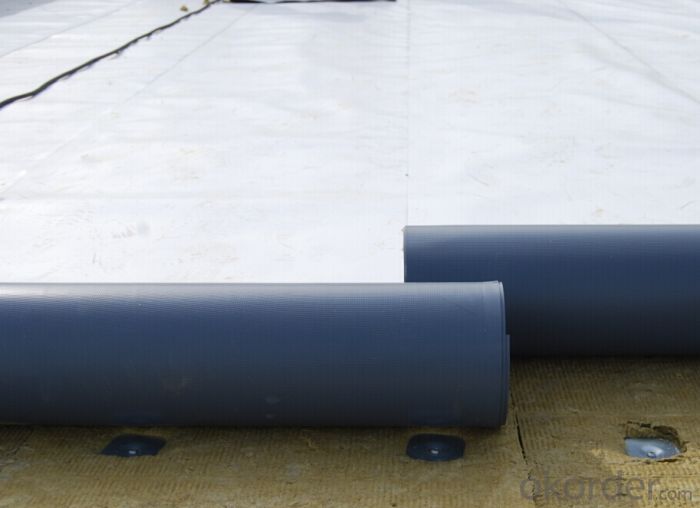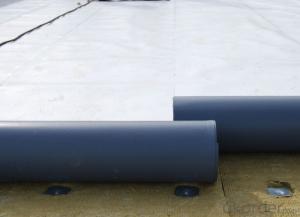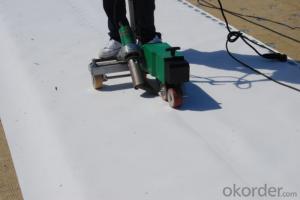TPO Waterproof Roofing Membrane Thickness with 1.2 mm
- Loading Port:
- Qingdao
- Payment Terms:
- TT OR LC
- Min Order Qty:
- 5000 m²
- Supply Capability:
- 10000 m²/month
OKorder Service Pledge
OKorder Financial Service
You Might Also Like
Product Description:
Description Of TPO membrane:
Tpo waterproof roofing membrane for sale
1.high breathable membrane
2.market:all over the world
3.resonable price
Main Features of TPO membrane:
- Easy installation with good system integrity, need few accessories
- High tensile and tear strength, puncture resistance
- No plasticizer, heat aging and UV resistance, durable
- Hot-air welding, rapid welding speed, high peel strength (two times of PVC)
-No chlorine, 100% recyclable, environment friendly
- Durable hot-air welding performance and convenient maintainance
- Smooth surface, unfading and stain resistance
Product Advantages:
1. Weather resistance and durability; Excellent weld ability;
2. No any crisp agents to prevent materials brittleness;
3. Intermediate enhanced polyester mesh fabric to have high tensile strength, fatigue resistance and penetrating resistance suitable for mechanically attached roofing systems;
4. Excellent the same high and low temperature resistance as rubber materials which can keep flexible at -50° C and keep mechanical strength in high temperature;
FAQ:
1. What are we supplying?
We are specialized in producing Colorful Asphalt Roof Shingle, SBS/APP modified bitumen waterproof membrane, Self adhesive bitumen waterproof membrane, PVC waterproofing membrane, EPDM rubber roofing membrane, Single Component Polyurethane Waterproof Coating, and Spray Polyurea Waterproof Coating.
2. How Many years experience do we have?
We have been exported to more than 20 countries in the past 15 years.
3. How long do we usually reply your request?
We always reply our customer within 24 hours.


- Q:Are there any limitations to using a waterproofing membrane?
- There exist certain limitations when using a waterproofing membrane. To begin with, although waterproofing membranes are successful in preventing water penetration, they do not always serve as a solution for structural problems that may result in leaks. In the presence of underlying issues with the structure, such as cracks or gaps in the foundation or walls, solely relying on a waterproofing membrane may not sufficiently address the problem. Furthermore, the installation of a waterproofing membrane necessitates thorough surface preparation, which can be time-consuming and expensive. The surface must be meticulously cleaned, dried, and cleared of any debris or contaminants for the membrane to adhere properly. Inadequate surface preparation may lead to improper adherence of the membrane, potentially causing it to fail in providing effective waterproofing. Moreover, waterproofing membranes are prone to damage during installation or afterwards if not adequately maintained. The membrane can be punctured or torn by sharp objects or heavy equipment, thereby compromising its effectiveness. Regular inspections and maintenance are imperative to ensure the membrane remains intact and in good condition. Additionally, waterproofing membranes have a limited lifespan and can deteriorate over time. Exposure to UV radiation, extreme temperatures, or harsh chemicals can degrade the membrane, reducing its ability to prevent water penetration. Regular inspections and potential replacement may be necessary to uphold the integrity of the waterproofing. Lastly, not all structures or environments are suitable for waterproofing membranes. Certain membranes may not be compatible with specific substrates or may not withstand high hydrostatic pressure. It is crucial to consult a professional and select the appropriate membrane type for the specific project and conditions. In conclusion, while waterproofing membranes can effectively safeguard structures from water damage, it is essential to acknowledge their limitations and ensure correct installation and maintenance to optimize their performance.
- Q:Can a waterproofing membrane be used on tunnels with lighting systems?
- Yes, a waterproofing membrane can be used on tunnels with lighting systems. In fact, it is often necessary to use waterproofing membranes in tunnels to protect the structure from water infiltration. These membranes are designed to create a barrier that prevents water from seeping into the tunnel and causing damage. They are typically applied to the tunnel walls, floors, and ceilings and can be used in conjunction with lighting systems without any issues. The waterproofing membrane will not affect the functionality or safety of the lighting system and will help ensure that the tunnel remains watertight and protected from moisture-related issues.
- Q:What materials are commonly used for waterproofing membranes?
- Different materials are commonly used for waterproofing membranes, each having their own unique properties and advantages. Some of the most frequently used materials are as follows: 1. Bitumen: Due to its exceptional waterproofing properties, bitumen is a popular option for waterproofing membranes. It is a sticky, black, and viscous substance derived from petroleum. Often, it is blended with polymers to increase its flexibility, durability, and resistance to UV radiation. 2. PVC (Polyvinyl Chloride): PVC membranes are extremely durable and resistant to chemicals, making them suitable for a variety of waterproofing applications. They are easy to install and can withstand extreme temperatures, making them a preferred choice for flat roofs and underground structures. 3. EPDM (Ethylene Propylene Diene Monomer): EPDM is a synthetic rubber membrane that is highly flexible and durable. It can withstand UV radiation, ozone, and extreme temperatures, making it suitable for both above and below-ground applications. EPDM membranes are commonly used for roofs, foundations, and pond liners. 4. TPO (Thermoplastic Olefin): TPO membranes are a combination of rubber and plastic polymers, making them highly flexible, durable, and resistant to UV radiation. They are lightweight and easy to install, making them popular for commercial roofing applications. 5. HDPE (High-Density Polyethylene): HDPE membranes are manufactured from high-density polyethylene and are known for their excellent resistance to chemicals. They are commonly employed for waterproofing underground structures, such as tunnels and basements. 6. Bentonite: Bentonite clay is a natural material that expands when it comes into contact with water, creating a gel-like substance that seals cracks and pores. Bentonite membranes are frequently utilized for waterproofing below-ground structures and are highly effective in preventing water infiltration. 7. Liquid applied membranes: These membranes are typically composed of a combination of synthetic polymers and rubber. They are applied as a liquid and, once cured, form a continuous, seamless, and flexible waterproofing layer. Liquid applied membranes are versatile and can be used for various applications, including roofs, balconies, and foundations. It is important to note that the choice of material depends on the specific requirements of the project, including the type of structure, environmental conditions, and budget. Consulting with a waterproofing professional is recommended to determine the most suitable material for a particular application.
- Q:Can a waterproofing membrane be installed by a homeowner, or is professional installation necessary?
- While it is technically possible for a homeowner to install a waterproofing membrane, professional installation is highly recommended. Waterproofing membranes require specialized knowledge and expertise to ensure proper installation and effectiveness. Professionals have the necessary skills, tools, and experience to address potential challenges and ensure a long-lasting and reliable waterproofing solution. Additionally, professional installation often comes with warranties and guarantees, providing homeowners with added peace of mind.
- Q:Can a waterproofing membrane be used on plastic block surfaces?
- Indeed, it is possible to utilize a waterproofing membrane on surfaces composed of plastic blocks. These membranes are specifically engineered to serve as a safeguard against moisture, effectively hindering water infiltration. Similar to any other type of surface, plastic blocks are prone to water-related harm if not adequately shielded. By applying a waterproofing membrane, one can successfully seal and safeguard the plastic blocks, thus thwarting water permeation and potential destruction. To achieve optimal outcomes, it is crucial to select a waterproofing membrane that harmonizes with plastic materials and adhere to the manufacturer's application guidelines.
- Q:Is a waterproofing membrane resistant to rodent or insect infestation?
- A waterproofing membrane has the ability to resist infestation from rodents or insects. Most waterproofing membranes are constructed using materials that rodents or insects find unappealing, such as bitumen or synthetic polymers. Furthermore, these membranes are typically installed in a manner that eliminates any gaps or openings through which pests could enter. However, it should be noted that no waterproofing system is completely impervious to infestation. If there are existing entry points or if the membrane is damaged or improperly installed, rodents or insects may still be capable of breaching the waterproofing system. Regular inspection and maintenance are essential to ensure the integrity of the waterproofing membrane and to prevent any infestation from occurring.
- Q:Can a waterproofing membrane be used on masonry surfaces?
- Indeed, masonry surfaces can benefit from the utilization of a waterproofing membrane. Employing a waterproofing membrane on masonry surfaces is a prevalent approach to thwart water infiltration and subsequent harm. Concrete, brick, or stone masonry surfaces are permeable and have the capacity to absorb water, resulting in potential structural deterioration, growth of mold, and overall degradation over time. The purpose of a waterproofing membrane is to serve as a barrier, preventing water from permeating the masonry and safeguarding it against moisture-related predicaments. It is crucial to select a waterproofing membrane that is specifically engineered for masonry surfaces and adhere to the instructions provided by the manufacturer for appropriate application.
- Q:Can a waterproofing membrane be used in geotechnical applications?
- Yes, a waterproofing membrane can be used in geotechnical applications. It is commonly used to prevent water infiltration in structures such as tunnels, retaining walls, and basements. The membrane acts as a barrier, effectively sealing the structure and protecting it from water damage.
- Q:How do waterproofing membranes prevent water leakage?
- Waterproofing membranes prevent water leakage by creating a physical barrier between the structure and the water. These membranes are made of materials that are impermeable to water, such as rubber, PVC, or bitumen. When applied correctly, they form a continuous and seamless layer that prevents water from seeping through cracks, joints, or other vulnerable areas. This barrier effectively stops water from infiltrating the structure, ensuring its protection against water damage and leakage.
- Q:Can a waterproofing membrane be used in industrial facilities or warehouses?
- In industrial facilities or warehouses, it is possible to utilize a waterproofing membrane. These types of facilities typically have concrete floors or walls that are prone to water damage caused by leaks or moisture. By applying a waterproofing membrane, it becomes possible to shield these areas from water penetration, thereby preventing any potential harm to the structure and its contents. The purpose of waterproofing membranes is to establish a barrier that effectively prevents water from seeping through the surface, making them a practical solution for industrial facilities and warehouses where moisture control is of utmost importance. Furthermore, these membranes possess durability and can endure heavy foot traffic and equipment, making them ideal for use in areas with high levels of activity. Ultimately, the utilization of a waterproofing membrane in industrial facilities or warehouses plays a crucial role in maintaining a dry and secure environment, ensuring the protection of the structure and its contents.
1. Manufacturer Overview |
|
|---|---|
| Location | |
| Year Established | |
| Annual Output Value | |
| Main Markets | |
| Company Certifications | |
2. Manufacturer Certificates |
|
|---|---|
| a) Certification Name | |
| Range | |
| Reference | |
| Validity Period | |
3. Manufacturer Capability |
|
|---|---|
| a)Trade Capacity | |
| Nearest Port | |
| Export Percentage | |
| No.of Employees in Trade Department | |
| Language Spoken: | |
| b)Factory Information | |
| Factory Size: | |
| No. of Production Lines | |
| Contract Manufacturing | |
| Product Price Range | |
Send your message to us
TPO Waterproof Roofing Membrane Thickness with 1.2 mm
- Loading Port:
- Qingdao
- Payment Terms:
- TT OR LC
- Min Order Qty:
- 5000 m²
- Supply Capability:
- 10000 m²/month
OKorder Service Pledge
OKorder Financial Service
Similar products
New products
Hot products
Related keywords





























